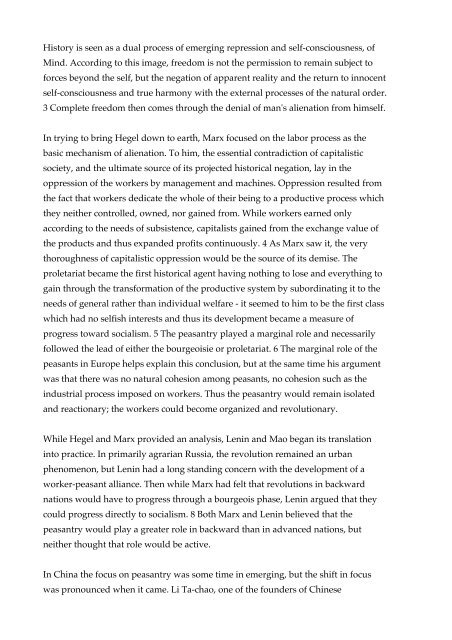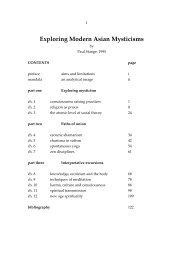Javanese Mystical and Marxist Dialectics - Paul Stange
Javanese Mystical and Marxist Dialectics - Paul Stange
Javanese Mystical and Marxist Dialectics - Paul Stange
You also want an ePaper? Increase the reach of your titles
YUMPU automatically turns print PDFs into web optimized ePapers that Google loves.
History is seen as a dual process of emerging repression <strong>and</strong> self-consciousness, ofMind. According to this image, freedom is not the permission to remain subject toforces beyond the self, but the negation of apparent reality <strong>and</strong> the return to innocentself-consciousness <strong>and</strong> true harmony with the external processes of the natural order.3 Complete freedom then comes through the denial of man's alienation from himself.In trying to bring Hegel down to earth, Marx focused on the labor process as thebasic mechanism of alienation. To him, the essential contradiction of capitalisticsociety, <strong>and</strong> the ultimate source of its projected historical negation, lay in theoppression of the workers by management <strong>and</strong> machines. Oppression resulted fromthe fact that workers dedicate the whole of their being to a productive process whichthey neither controlled, owned, nor gained from. While workers earned onlyaccording to the needs of subsistence, capitalists gained from the exchange value ofthe products <strong>and</strong> thus exp<strong>and</strong>ed profits continuously. 4 As Marx saw it, the verythoroughness of capitalistic oppression would be the source of its demise. Theproletariat became the first historical agent having nothing to lose <strong>and</strong> everything togain through the transformation of the productive system by subordinating it to theneeds of general rather than individual welfare - it seemed to him to be the first classwhich had no selfish interests <strong>and</strong> thus its development became a measure ofprogress toward socialism. 5 The peasantry played a marginal role <strong>and</strong> necessarilyfollowed the lead of either the bourgeoisie or proletariat. 6 The marginal role of thepeasants in Europe helps explain this conclusion, but at the same time his argumentwas that there was no natural cohesion among peasants, no cohesion such as theindustrial process imposed on workers. Thus the peasantry would remain isolated<strong>and</strong> reactionary; the workers could become organized <strong>and</strong> revolutionary.While Hegel <strong>and</strong> Marx provided an analysis, Lenin <strong>and</strong> Mao began its translationinto practice. In primarily agrarian Russia, the revolution remained an urbanphenomenon, but Lenin had a long st<strong>and</strong>ing concern with the development of aworker-peasant alliance. Then while Marx had felt that revolutions in backwardnations would have to progress through a bourgeois phase, Lenin argued that theycould progress directly to socialism. 8 Both Marx <strong>and</strong> Lenin believed that thepeasantry would play a greater role in backward than in advanced nations, butneither thought that role would be active.In China the focus on peasantry was some time in emerging, but the shift in focuswas pronounced when it came. Li Ta-chao, one of the founders of Chinese




